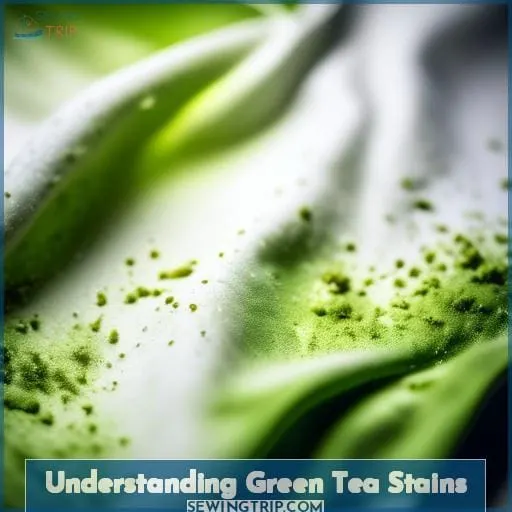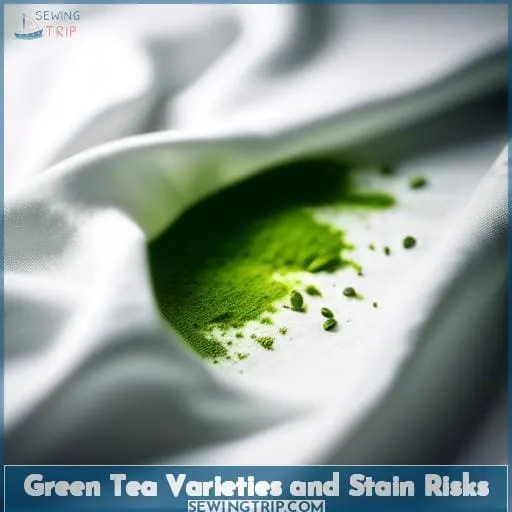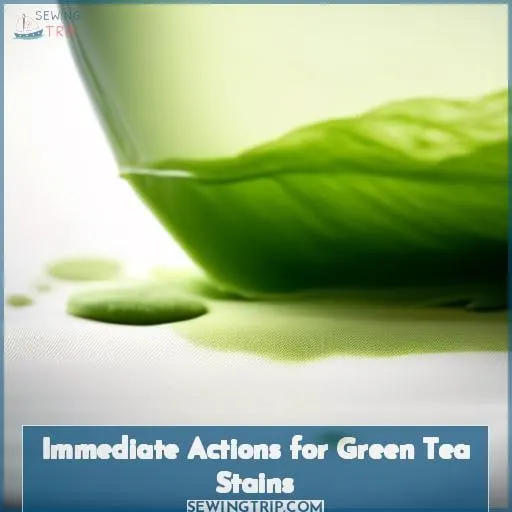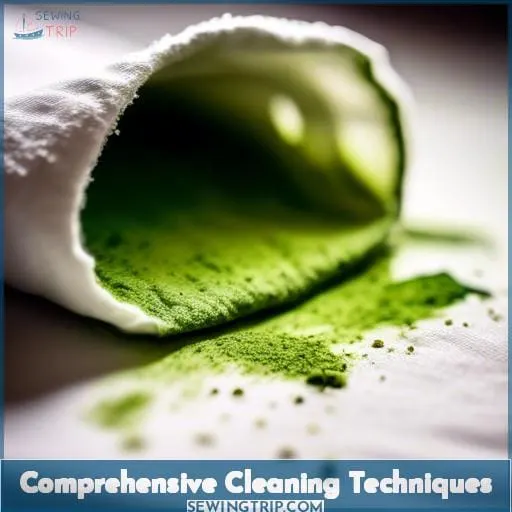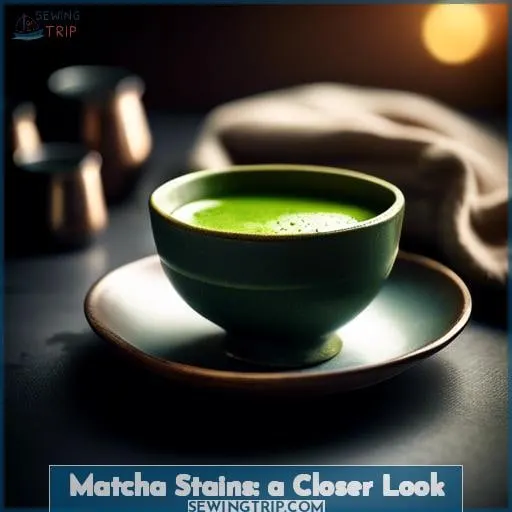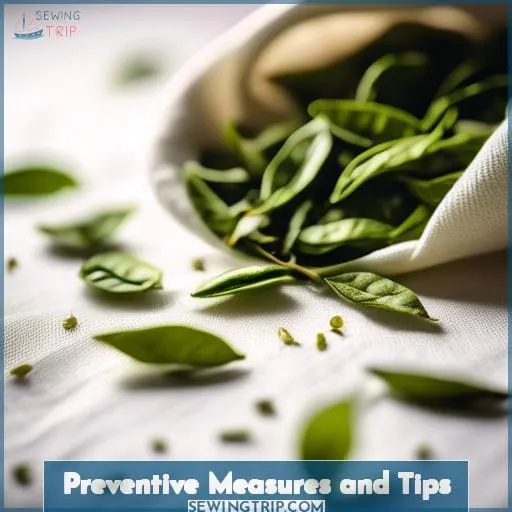This site is supported by our readers. We may earn a commission, at no cost to you, if you purchase through links.
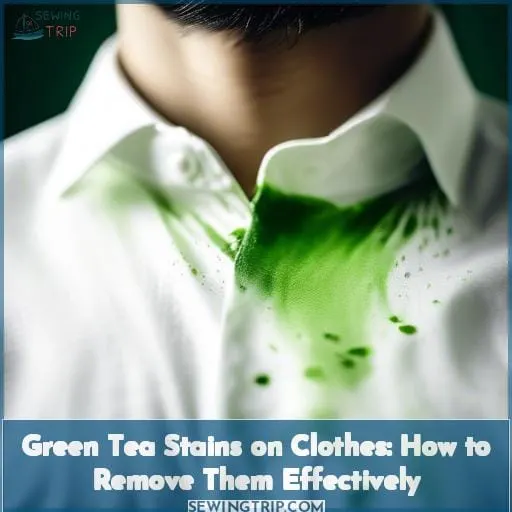 Nearly 80% of adults drink tea, making it a beloved daily ritual for many. Yet, this cherished beverage can leave its mark, quite literally, on our clothes.
Nearly 80% of adults drink tea, making it a beloved daily ritual for many. Yet, this cherished beverage can leave its mark, quite literally, on our clothes.
Green tea stains, though less notorious than their black tea counterparts, still pose a unique challenge due to the presence of tannins. These natural compounds, while enriching the tea’s flavor and color, cling to fabric fibers when spilled, creating stubborn stains.
Whether it’s the vibrant matcha or the deeply-steamed Fukamushi Sencha, each variety has its own staining potential. But fear not, for understanding the science behind these stains and mastering a few effective removal techniques can keep your wardrobe safe from these accidental green splotches.
Table Of Contents
Key Takeaways
- Green tea stains clothing less than black tea due to its lower tannin content, but certain varieties like Matcha and Fukamushi Sencha can cause more prominent stains.
- Matcha stains are challenging to remove because of the high concentration of leaf particles, despite its low tannin levels.
- Immediate action to treat green tea stains includes blotting with a clean cloth, rinsing under cold water, and applying a solution of mild dish soap or laundry detergent.
- For comprehensive cleaning, a solution should be applied to the stain, dabbed gently, and if necessary, a soft-bristled brush can be used before rinsing thoroughly with cool water.
Understanding Green Tea Stains
When it comes to understanding green tea stains on clothes, it’s essential to recognize the role of tannins.
While green tea has a lower tannin content compared to black tea, it can still cause discoloration on fabrics.
Knowing the difference in stain potential between green and black tea can guide you in preventing and treating stains effectively.
Role of Tannins in Staining
Tannins play a crucial role in the staining of clothes by green tea. These natural compounds, found in tea leaves, have a unique ability to bind with the fibers of your clothing, leading to discoloration.
The staining potential of green tea largely depends on its tannin content, which varies across different tea types. While green tea is known for its lower tannin levels compared to black tea, it can still cause stains.
Interestingly, matcha, a type of green tea made from powdered leaves, presents a unique challenge. Despite its lower tannin content, matcha stains are more prominent due to the high concentration of leaf particles that directly interact with fabric.
This makes matcha stains distinctively green, unlike the brownish stains typically associated with tannins in other teas.
Understanding these factors is key to effectively addressing green tea stains on clothes, ensuring that your favorite garments remain pristine.
Green Vs. Black Tea Stain Potential
When comparing green tea to black tea, the key difference lies in their tannin content. Green tea leaves generally have a lower tannin level than black tea, which directly influences their staining severity.
While both can leave marks, black tea’s higher tannin concentration makes its stains more pronounced and potentially harder to remove. However, don’t underestimate green tea, especially varieties like matcha, which, despite its lower tannin content, can still challenge your stain removal techniques.
Crafting a stain-fighting potion with the right stain remover is crucial for tackling these tea-induced discolorations effectively.
Green Tea Varieties and Stain Risks
When exploring the world of green tea, it’s crucial to understand that not all varieties stain equally.
Fukamushi Sencha, known for its longer steaming process, breaks down leaf particles that can adhere to fabrics, increasing its staining potential.
Similarly, Matcha, a powdered form of green tea, presents unique challenges due to its high concentration of leaf particles, making it more likely to stain clothes than other green teas.
These differences highlight the importance of being mindful of the specific green tea variety you’re enjoying, especially if you’re concerned about stains.
Fukamushi Sencha’s Staining Properties
As we delve into the unique world of Fukamushi Sencha, it’s essential to understand why this particular green tea variety poses a higher risk of staining your clothes. Unlike its counterparts, Fukamushi Sencha undergoes a longer steaming process, which significantly impacts its staining properties.
- Leaf Particle Size: The extended steaming breaks down the tea leaves into smaller particles. These tiny leaf fragments can more easily adhere to fabric, increasing the likelihood of stains.
- Leaf Concentration: With a higher concentration of broken leaves, Fukamushi Sencha releases more color and flavor when brewed. This intensity translates to a greater staining potential on clothes.
- Antioxidants: While beneficial for health, the antioxidants in Fukamushi Sencha contribute to the staining process. Their interaction with fabric fibers can lead to more stubborn stains.
- Temperature and Brewing Time: The optimal brewing conditions for Fukamushi Sencha—using hotter water and a longer brewing time—can exacerbate staining. Hotter liquids penetrate fabrics more deeply, and prolonged exposure allows more color to transfer.
Understanding these factors is crucial for tea enthusiasts who wish to enjoy Fukamushi Sencha without the worry of staining. Whether you’re dealing with matcha stains or the rich hues of Fukamushi Sencha, being informed about tea stain removal techniques can save your favorite garments from permanent discoloration.
Matcha’s Unique Staining Challenges
Matcha, a finely ground powder made from green tea leaves, presents unique challenges when it comes to staining clothes. Unlike traditional green teas, matcha’s high concentration of leaf particles means that when it spills, a significant amount of material contacts the fabric, leading to stains.
These stains aren’t primarily due to tannins, as is common with other teas, but rather the physical presence of the leaf particles themselves. This characteristic makes matcha stains particularly stubborn, as they embed directly into the fibers of clothing.
To combat matcha stains, immediate action is crucial. Blotting the stain gently with a clean cloth or paper towel helps absorb the liquid before it sets. Creating a cleaning solution with mild dish soap or laundry detergent and cool water is the next step.
Applying this solution to the stain and gently rubbing it with a soft-bristled brush or toothbrush can help loosen and lift the leaf particles. Rinsing the area with cool water and repeating the process as necessary can effectively reduce or remove the stain.
For persistent matcha stains, turning to a fabric-specific stain remover and following the product’s instructions carefully can offer a solution. Patience and persistence are key, as some stains may require multiple treatments to fully disappear.
Matcha’s unique staining challenges stem from its composition and the way it interacts with fabric, making it a notable exception in the realm of tea-related stains.
Immediate Actions for Green Tea Stains
When you notice a green tea stain on your clothes, it’s crucial to act swiftly to prevent the stain from setting.
Start by blotting the affected area with a clean cloth to absorb as much of the tea as possible.
Then, rinse the stain under cold water to dilute the tea’s pigments, which can help minimize the discoloration before you treat the fabric further.
Importance of Quick Response
When it comes to green tea stains on clothes, time sensitivity is crucial. The quicker you respond to a spill, the easier it will be to remove the stain. This rapid response prevents the tannins in the tea from bonding too firmly with the fabric fibers, making the stain less stubborn.
- Blot the Stain: Use a clean cloth or paper towel to gently blot the spill, absorbing as much of the tea as possible without rubbing it into the fabric.
- Rinse with Cold Water: Flush the stained area with cold water from the backside of the fabric. This helps push the stain out rather than deeper into the material.
- Apply a Cleaning Solution: Mix a small amount of laundry detergent, dishwashing liquid, or a paste made from baking soda and water, and apply it to the stain. Gently rub the area with a soft-bristled brush or toothbrush.
Prompt action, combined with the right cleaning techniques, can significantly increase your chances of completely removing green tea stains from your clothes.
Initial Cleaning Steps
When you’re faced with a green tea stain, it’s crucial to act swiftly to prevent the stain from setting.
Start by blotting the stain with a clean cloth to absorb as much liquid as possible.
Next, prepare a stain solution by mixing a small amount of mild dish soap with cool water. Apply this mixture to the stained area, using a soft-bristled brush to gently work it into the fabric.
Rinse the area with cool water to remove any soapy residue. If the stain persists, repeat these initial cleaning steps until the stain lightens or is no longer visible.
Comprehensive Cleaning Techniques
When tackling green tea stains on clothes, it’s essential to act quickly and use the right cleaning solution.
You’ll want to start by blotting the stain with a clean cloth to remove any excess liquid.
Then, create a mixture of mild dish soap or laundry detergent with cool water to treat the area.
For more stubborn stains, a soft-bristled brush can help work the solution into the fibers before rinsing thoroughly with cool water.
Creating a Cleaning Solution
After quickly addressing a green tea spill, it’s time to craft a cleaning solution that’s both effective and gentle on fabrics. Start by mixing a small amount of mild dish soap or laundry detergent with cool water.
This blend is crucial for treating green tea stains, including those from matcha, which stains more due to its high leaf concentration. The cool water benefits here are twofold: it prevents the stain from setting further and is gentle on most fabrics.
Apply this solution by dabbing gently onto the stain, starting from the outside to prevent spreading. This dabbing technique is preferred over scrubbing, which can embed the stain deeper into the fabric.
For matcha stains, which are green and not primarily caused by tannins, this method is particularly effective.
In cases where matcha stains prove stubborn, a specialized fabric stain remover might be necessary. These products are formulated to tackle difficult stains and should be used according to the manufacturer’s instructions for the best results.
Remember, patience and persistence are key when treating green tea stains, especially those from matcha, which can be more challenging due to its unique composition.
Techniques for Stubborn Stains
For those stubborn green tea stains that refuse to budge, you’ll need to adopt a more comprehensive approach.
Start by mixing a home remedy like baking soda with a bit of water to create a paste. Apply this directly to the stain and let it sit overnight. This method draws the stain out of the fabric, making it easier to remove.
If the stain persists, consider using a professional cleaning product or a melamine eraser for a more targeted approach.
For delicate items like vintage upholstery or a collectible teapot, it’s best to consult a professional cleaner or consider dry cleaning to avoid damage.
Matcha Stains: a Closer Look
When tackling matcha stains on your clothes, it’s important to understand that matcha’s vivid green color comes from chlorophyll, not tannins, which are typically responsible for tea stains.
Despite its low tannin content, matcha can still cause more noticeable stains than other teas due to its high concentration of leaf particles.
To effectively remove these stains, prompt action and the right cleaning techniques are crucial.
Why Matcha Stains Differently
After exploring comprehensive cleaning techniques for green tea stains, it’s crucial to understand why matcha, in particular, presents unique stain removal challenges. Unlike other teas, matcha’s staining mechanism isn’t primarily due to tannins, which are common in teas like black tea and are known for their staining properties.
Instead, matcha stains clothes because of its fine particle size and high leaf concentration. When you spill matcha, you’re essentially dropping a concentrated amount of tiny leaf particles onto the fabric.
These particles, averaging around 6.1 microns, are so small that they can easily adhere to and penetrate clothing fibers, making the stains particularly stubborn.
Moreover, matcha’s vibrant green stain color difference from the typical brown of tannin-based tea stains adds another layer to the stain removal challenges. This unique color is due to matcha’s rich chlorophyll content, a result of the shade-growing process that enhances the green pigment in the leaves.
The low tannin content in matcha means that while it may stain more intensely due to the concentration of leaf material, the approach to tackling these stains differs from those caused by tannins.
Understanding the matcha stain mechanism, including the role of matcha particle size and leaf concentration, is essential for effectively addressing matcha stain removal challenges. This knowledge empowers you to take swift and appropriate action, ensuring your clothes can be restored to their original state with patience and the right techniques.
Matcha’s Low Tannin Content
Understanding the unique staining properties of matcha requires a closer look at its composition, particularly its low tannin content.
Unlike black tea, which is known for its high tannin levels and resultant strong staining potential, matcha’s staining mechanism operates differently. Tannins, the polyphenols responsible for the brownish stains left by many teas, are present in significantly lower quantities in matcha.
However, this doesn’t mean matcha is stain-free. The key to matcha’s staining ability lies in its form—being a finely powdered green tea, it contains concentrated leaf particles.
This high concentration of leaf material, rather than tannins, is what makes matcha particularly adept at staining clothes. Therefore, while matcha may have a lower tannin content, its unique powdered form and the presence of leaf particles make it a notable staining agent.
Preventive Measures and Tips
When it comes to keeping your clothes free from green tea stains, a little foresight goes a long way.
You’ll find that being quick to act and using the right materials can prevent these stains from becoming a permanent part of your wardrobe.
By understanding the nature of tea stains and employing effective cleaning techniques, you’re well-equipped to tackle any spills that come your way.
Handling Tea Stains on Various Surfaces
Tea stain removal requires swift action across all surfaces. For carpets, blend dishwashing liquid, vinegar, and water, applying this mixture gently to lift the stain.
When tackling furniture, this same solution can refresh fabrics without harsh chemicals.
Mug and china stains meet their match with a paste of baking soda and water, scrub lightly to preserve the surface.
Long-term Stain Prevention Strategies
To ensure your clothes remain vibrant and free from green tea stains, adopting long-term stain prevention strategies is key.
Fabric protection begins with understanding the materials you’re dealing with. Opt for stain repellent treatments for your garments to boost tea stain resistance. This proactive approach not only guards against accidental spills but also preserves the integrity of your fabrics.
When enjoying your favorite teas, especially those prone to staining like matcha or fukamushi sencha, consider using protective aprons or changing into less cherished attire. Regularly treating your clothes with fabric protectors can offer an additional layer of defense, making them less susceptible to stains.
Frequently Asked Questions (FAQs)
Can green tea stains affect the colorfastness of different fabric types differently, potentially leading to permanent discoloration in some materials?
Green tea stains can indeed affect different fabrics uniquely, potentially causing permanent discoloration.
Especially in more absorbent or delicate materials.
How does the pH level of green tea influence its staining potential, and are there any ways to adjust the pH to minimize staining?
Green tea’s acidic pH can enhance its staining potential on fabrics.
By neutralizing the tea with a bit of baking soda to adjust its pH, you’ll significantly reduce the risk of stubborn stains.
Are there any natural or household remedies not commonly known that can effectively remove green tea stains without damaging delicate fabrics?
You can try a paste of baking soda and water to gently lift green tea stains from delicate fabrics.
How do environmental factors, such as humidity and temperature, impact the setting of green tea stains on clothes and their subsequent removal?
High humidity and warm temperatures can turn a green tea spill into a stubborn stain.
To remove, act quickly with cool water and gentle detergents.
Can the use of green tea in DIY beauty treatments, such as face masks or hair rinses, pose a risk of staining to towels, bedding, or clothing, and how can these stains be prevented or removed?
Yes, using green tea in DIY beauty treatments can risk staining towels, bedding, or clothing due to tannins and leaf particles.
Prevent stains by using dark-colored or designated towels and washcloths.
Remove stains by rinsing in cold water, applying a mixture of dish soap and water, gently rubbing, and rinsing again.
Conclusion
Battling green tea stains on clothes might seem like a Herculean task, but with the right knowledge and swift action, you can emerge victorious.
By adopting these preventive measures and stain-fighting techniques, you’ll keep your wardrobe in pristine condition, free from the clutches of even the most persistent green tea stain.

